NR509 Week 4: Midterm [CORRECT ANSWERS for current exam]
1. Which of the following statements best describes a differential diagnosis list?
A. It is a list of planned interventions for the problems assessed during the visit.
B. It is the list of concerns brought to the appointment by the patient.
C. It is a list of different diagnoses experienced by the patient in the past.
D. It is a list of potential/plausible diagnoses that may be causing the patient’s signs and symptoms.
E.It is a list of diagnoses that have already been ruled out as causes for the chief complaint.
2. A 66-year-old female presents to the primary care office with complaints of jaw pain, fatigue, and nausea for
the last 48 hours. What course of action is appropriate in the treatment of this patient?
A. Refer the patient to an otolaryngologist to evaluate for jaw pain.
B. Prescribe the medication for the jaw pain and nausea and reevaluate in 2-3 days.
C. Order x-rays of the jaw and abdomen to further evaluate.
D. Recognize these could be atypical symptoms of acute coronary syndrome and proceed accordingly.
E. Order screening blood work to evaluate for thyroid disease
3. In an adult over the age of 40, an S3 assessment finding on cardiac auscultation may be indicative of what?
Select all that apply.
A. anemia
B. myocardial infarction
C. heart failure pg 551
D. normal for athletes – pg 522
E. ventricular volume overload from aortic or mitral regurgitation – pg 551
4. A 72-year-old male is admitted to intensive care from the Emergency Room for the initial complaint of chest
pain. After the history and physical examination, the NP documents the following cardiovascular findings:
JVP is 5 cm above the sternal angle with the head of the bed elevated to 50°. Carotid upstrokes are
brisk; a bruit is heard over the left carotid artery. The PMI is diffuse, 3 cm in diameter, palpated at the
anterior axillary line in the fifth and sixth intercostal spaces. S1 and S2 are soft. S3 is present at the
apex. High-pitched harsh 2/6 holosystolic murmur best heard at the apex, radiating to the axilla.
Which of the following possible diagnoses is based on the accurate interpretation of the assessment
findings?
A. These findings suggest heart failure.
B. These findings suggest previous myocardial infarction.
C. These findings suggest right carotid occlusion.
D. These findings suggest mitral stenosis.
E. These findings suggest aortic aneurysm.
5. A 76-year-old male presents to the office for a routine physical examination. The NP documents the
following skin findings:
Decreased elasticity with multiple lentiginous macules on habitually sun-exposed skin. Multiple,
discrete, brown, stuck-on, non-indurated, verrucous plaques on the back and abdomen varying from
1-2 centimeters.
Which of the following is the most accurate interpretation of these findings?
A. These findings suggest seborrheic keratoses.
B. These findings suggest actinic keratoses.
C. These findings suggest malignant melanoma.
D. These findings suggest lichen planus.
E. These findings suggest psoriasis.
6. A 14-year-old male presents to the clinic with his grandmother for a complaint of a sore throat. The patient
is afebrile and denies cough. After completing the history and physical examination, the NP documented the
following partial assessment findings:
Throat—Oral mucosa pink, dental caries in lower molars, tongue midline, uvula, and pharynx
erythematous, bilateral tonsils enlarged, no exudates.
Neck—Trachea midline. Neck supple; thyroid isthmus midline, lobes palpable but not enlarged.
Lymph Nodes—Submandibular and anterior cervical lymph nodes tender, 1 cm × 1 cm, rubbery and
mobile; no posterior cervical, epitrochlear, axillary, or inguinal lymphadenopathy.
Which of the following is the most accurate interpretation of the findings?
A. These findings suggest pharyngitis.
B. These findings suggest tonsillar abscess.
C. These findings suggest lymphoma.
D. These findings suggest mononucleosis.
E. These findings suggest upper respiratory illness.
7. The NP is assuming care for a 56-year-old female resident of a long-term assisted living facility. The woman
is seated in a wheelchair next to a window in her private room. After completing the history and physical
examination, the NP documented the following mental status findings:
The patient appears sad and fatigued; clothes are wrinkled. Speech is slow and words are mumbled.
Thought processes are coherent, but insight into current life reverses is limited. The patient is oriented
to person, place, and time. Digit span, serial 7s, and calculations accurate, but responses delayed.
Clock drawing is good.
Which of the following is the most accurate interpretation of the findings?
A. These findings suggest depression.
B. These findings suggest anxiety.
C. These findings suggest mood disorder.
D. These findings suggest a neurocognitive disorder.
E. These findings suggest intellectual disability
8. The NP conducted a physical assessment on a 74-year-old male with a complaint of shortness of breath.
His history is significant for a 20 pack-year history of smoking. He uses 2 inhalers daily (medication unknown)
but did not bring them with him to his appointment. The documentation for the respiratory findings is as
follows:
Which of the following is the most accurate interpretation of the findings?
A. These findings suggest COPD. – total guess (2 inhalers – smoker? – makes me think emphysema not list)
B. These findings suggest pneumonia.
C. These findings suggest asthma.
D. These findings suggest chronic bronchitis.
E. These findings suggest left-sided heart failure.
9. A 28-year-old female presents to the office for an annual physical examination. The NP is evaluating the
cranial nerves (CNs) while assessing the eyes. The findings are represented in this image. Damage or
inflammation of which of the following cranial nerve(s) is demonstrated in this image?
ADA Description: Eyes looking right and looking left.
A. CN II
B. CN III somewhat of a guess
C. CN IV
D. CN V
E. CN VI
10. Otoscopic examination of the patient’s left ear reveals the assessment findings represented in this image.
What is the best documentation for the assessment findings of the tympanic membrane and external auditory
canal?
ADA Description: Left ear, tympanic membrane, and external canal.
A. Bulging TM with gray, translucent appearance. No effusion. Non-erythematous external canal without exudate.
B. Retracted TM with gray, translucent appearance. No effusion. Erythematous, edematous, external canal
without exudate.
C. Retracted TM. Effusion with amber fluid. Non-erythematous external canal without exudate.
D. Bulging TM with yellow, purulent, fluid level. Erythematous, edematous, external canal without exudate.
E. Bulging TM with yellow, translucent fluid. Non-erythematous external canal without exudate
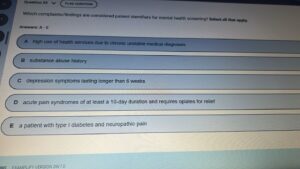

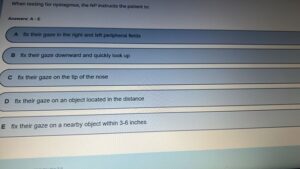
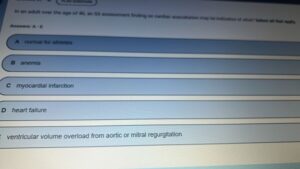
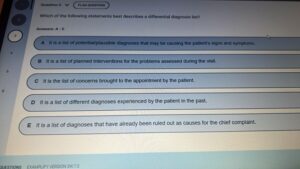
…………………………………………………..purchase the entire exam questions and answers (80-100% correct) at $100 only

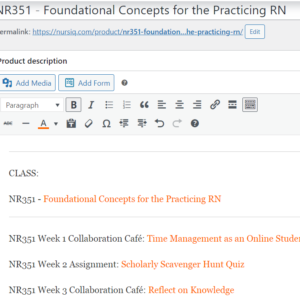

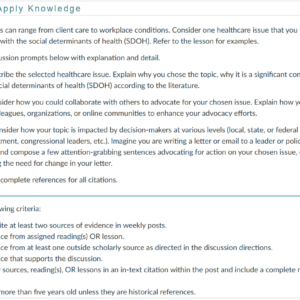
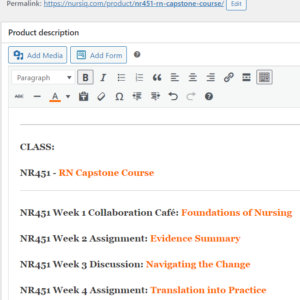
Reviews
There are no reviews yet.